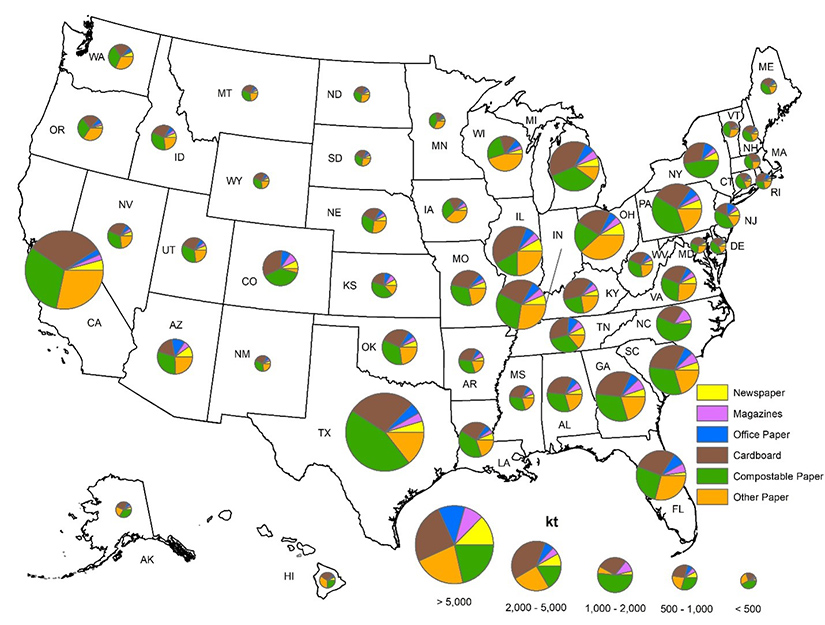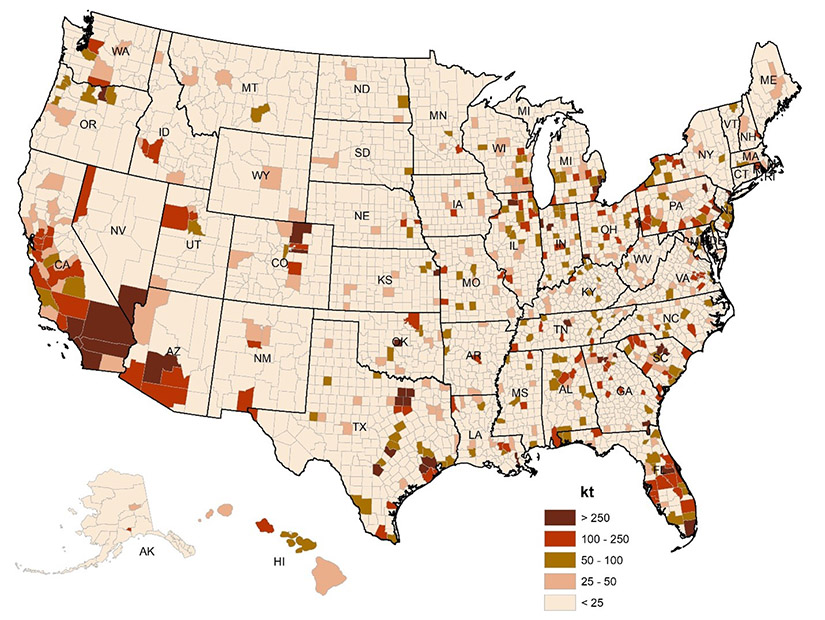Posted by Johann Nacario — April 26, 2024 — Piles of cardboard and paper waste littering America’s landfills represent $4 billion in lost economic value, according to a new analysis by researchers at the U.S. Department of Energy’s National Renewable Energy Laboratory (NREL).

Paper and cardboard waste landfilled in 2019 by type and state. The pie charts’ sizes represent the quantity of landfilled material in kilotons. The material types are shown as a percentage of total landfilled material in different colors. Image from NREL. Click to enlarge.
“That value is lost by landfilling,” said Anelia Milbrandt, a senior research analyst in NREL’s Strategic Energy Analysis Center and lead author of a new research paper, “Paper and cardboard waste in the United States: geographic, market, and energy assessment.”
The article, which appears in the journal Waste Management Bulletin, was co-authored by NREL colleagues Jarett Zuboy, Kamyria Coney and Alex Badgett and funded by DOE’s Bioenergy Technologies Office.
The analysis, which relied on figures from 2019, is the latest effort by Milbrandt and Badgett to focus attention on what is clogging the country’s landfills. They previously examined what could be done with food waste disposed in landfills and the mountains of plastic waste tossed in the garbage. The collective goal of these studies is to guide policymakers toward sustainable waste management and to help researchers consider the potential impact of implementing new waste management technologies.
Jarett Zuboy, a markets and policy analyst in the Strategic Energy Analysis Center, stated:
Improved strategies for managing paper and cardboard waste can provide substantial energy, environmental, and economic benefits. To realize these benefits, it’s important to characterize the waste resource comprehensively.
The study maps where cardboard and paper waste has been landfilled.
Of the estimated 110 million metric tons of paper and cardboard waste tossed out across the United States in 2019, approximately 56% was landfilled and 38% was recycled. The rest was burned. This category of waste constitutes about a quarter of municipal solid waste and includes everything from newspapers and magazines to books and napkins, from junk mail and photographs to pizza boxes and milk cartons.
Milbrandt remarked:
The U.S. is one of the world’s top waste producers, and most of it goes to landfills. The energy and resource values of materials put into landfills are lost. We can do better if we want to achieve a circular economy. Through our geospatial analysis, we illustrate “hot spots,” or areas with substantial opportunities to divert paper and cardboard waste from disposal facilities and hopefully stimulate investments in recovering their technical and economic value.
The Southeastern United States had the highest percentage of landfilled paper and cardboard waste, at about 25%. Within that region, as much as 30% of municipal solid waste came from this waste category in Florida and Tennessee.
Zuboy pointed out:
Paper and cardboard waste are among the many things that are used but not used up. Natural resources, money and energy are required to make paper and cardboard products, and after those products fulfill their original purpose, improved waste management strategies can be used to retain some of that value.

Cardboard and paper waste landfilled in 2019 by county, as measured in kilotons. Image by NRELMap courtesy of NREL. Click to enlarge.
Using three-year national average prices for recovered post-consumer paper and cardboard to estimate the market value of landfilled waste, the researchers put the figure at $4 billion. That is also almost the same amount communities spent to landfill paper and cardboard waste. In addition, the amount of embodied energy — accounting for all the energy required to manufacture these landfilled paper and cardboard wastes — equated to 9% of what the U.S. industrial sector used during 2019.
The researchers conducted a bottom-up analysis of paper and cardboard waste at 1,776 active landfills and 85 combustion facilities in the United States and produced a breakdown of where the material is winding up. Landfills typically are located near population centers, where more waste is generated. In some cases, however, where the waste winds up can be far from where it began. For example, trash from New York City can be found in landfills in Virginia and South Carolina. Landfill operators charge tipping fees to accept waste materials, and those fees are typically lower in rural areas, so it becomes economically feasible in certain instances to transport waste longer distances.
In addition to the energy expended for manufacturing and the lost economic value, landfilling paper and cardboard contributes to methane emissions, waste-disposal fees, deforestation, and local siting and environmental issues, the researchers noted. Fortunately, this category of waste is amenable to strategies — including reuse, recycling, composting, and energy recovery — that can mitigate the drawbacks of landfilling.
The U.S. Department of Energy’s Bioenergy Technologies Office funded the research.




